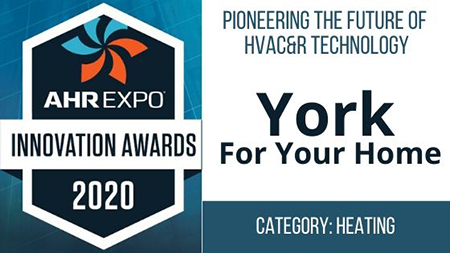

Reducing Emissions, Providing Comfort
Designing a furnace to lower emissions of smog precursors in areas such as Los Angeles and California’s San Joaquin Valley meant redesigning a furnace systems’ burner.
Over the last few decades, those areas’ air quality and safety have improved, but as the population continues to grow, emissions must continue to decrease to maintain the air quality advances that have been achieved, said Tom Tasker, product manager of residential furnaces & IAQ for Johnson Controls.
“By reducing the emission of nitrogen oxides (NOx) from gas furnaces, fewer smog precursors are available to combine with dust and smoke particles in the air,” he said.
The winner of the 2020 AHR Expo Innovation Awards’ heating category increases energy efficiency with reduced nitrogen oxide emissions. The YORK® (Booth 3801) LX Series TL9E Ultra-Low NOx Gas Furnace reduces emissions by up to 65% vs. standard low-NOx furnaces, and the furnace can reduce fuel costs as much as 20% when connected to select YORK home comfort systems.

The gas furnace is designed to meet demanding emission standards as Johnson Controls continues to develop solutions that meet the industry’s standards and help solve the challenges of the future, said Tasker. (YORK is a brand of Johnson Controls.)
“As regulatory standards continue to evolve toward reduced emissions and increased energy efficiency, both homeowners and contractors will be required to seek ultra-low NOx gas furnace options. YORK has provided a clear path to meeting these demands without sacrificing performance or ease of installation,” said Tasker.
NOx emissions have been identified as a contributing factor to smog, which can be an irritant to people, said Tasker. By significantly reducing NOx emissions, the furnace can improve a home’s environment while reducing fuel costs and providing comfort, he said.
“By using a revolutionary burner design, YORK Ultra-Low NOx gas furnaces reduce greenhouse and smog-producing gasses by up to 65% compared to standard low-NOx furnaces. This translates into significantly improved air quality both inside the home and for the environment,” he said. “At the same time, fuel costs can be reduced as much as 20% thanks to an exceptionally high 95% AFUE efficiency rating.”
Redesigning the Burner
To develop a product that meets customer needs and regulatory compliance, a broad team of engineers, technicians, manufacturing engineers, product management, supply chain and sales professionals collaborated to create this furnace, said Tasker. The furnace’s new burner design required the team to rethink the way a furnace burns gas to produce heat.
“Our teams have engineered a furnace that is fundamentally different in the way that the fuel and air mixes and burns. By mixing the fuel and air more completely prior to ignition, the result is a cleaner burn that reduces the emission of nitrogen oxides (NO and NO2),” Tasker said.
The furnaces’ cabinet designs reduce air leakage to less than 1%, which ensures more conditioned air goes to the areas of the house, said Tasker. The system also has stainless-steel primary and secondary heat exchangers.
This redesign is what is required to produce a low-emissions furnace and requires the product to tightly control the way fuel and air mixes and how combustion happens to control the emissions output, he said, adding that this will ultimately lead to increased sustainability and environmental responsibility.
"It could be the next frontier of improving furnace products across the industry," he said.
Tasker said Johnson Controls is constantly looking for solutions that decrease emissions and increase sustainability. The manufacturing facility where these furnaces are built in Wichita, Kansas, uses wind and solar resources today and will be 100% powered by wind energy by the end of 2020, he said.
YORK Ultra-Low NOx gas furnaces have been field tested and approved to ensure reliable performance. Tasker said some Johnson Controls engineers have been using these furnaces in their homes for several years, so they know about the products and that they are engineered the meet the demands of winter.
For additional coverage of AHR Expo, visit ASHRAE Journal’s AHR Today web page.